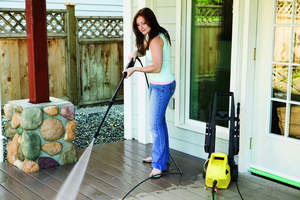MISSION, KS--(Marketwire - May 17, 2010) - (Family Features) With warm weather here, it's time to open the windows, swap out old patio furniture and prepare the home for sunny days. This year, homeowners can take matters into their own hands to enhance their homes with DIY home improvement projects.
HGTV "Design on a Dime" and TLC "Unhinged" home maintenance expert Summer Baltzer explains, "Whether fixing the kitchen sink disposal or creating a protective barrier against unwanted bugs around the home, homeowners should feel empowered to tackle DIY tasks this time of year."
Baltzer is partnering with Raid Max Bug Barrier to offer easy and affordable DIY tips that homeowners with a can-do attitude can undertake to protect their homes and families.
Be Bug Savvy
Baltzer knows protecting their home and family against bugs is a top priority for women. In fact, the Raid Max Bug Barrier Survey showed that almost 85 percent of women believe it is important to protect their home from uncontrolled pests, while six in 10 women are uncertain of how or where bugs enter the home.
"When fighting undesired bugs, it's important to treat the common insect entry points of the home," said Baltzer. "I like to use the new Raid Max Bug Barrier which creates an invisible line of defense against unwanted pests before they enter the home." Proper application of the specially formulated insecticide, with an automatic trigger that releases a continuous, evenly dispersed spray, helps keep unwanted pests where they belong -- out of the home.
Show Unwanted Bugs Who's Boss
It can be hard to determine where uncontrolled pests get in, so take these measures to ensure your home and family are protected.
-- Check doors and windows for small cracks or holes where unwanted bugs can enter.
-- Be sure to spray the indoor and outdoor perimeter of the home with Raid Max Bug Barrier, creating a line of defense.
-- Simply press and hold the battery-powered trigger to form a barrier around the home.
-- Re-apply if there is heavy rainfall in your area for a barrier of protection around the home -- for up to 12 months for German cockroaches.
Tackle Outside Cleanup
The elements can be harsh on the exterior of the home. Here are some tips for taking care of some often neglected outside cleanup chores.
Wash Siding
Pressure washers are a good way to clean vinyl, metal and some types of masonry siding. You can rent a pressure washer from most rental equipment dealers for around $50 to $75 per day.
Pressure washers deliver extreme pressure and can cause damage if misused. Safety tips:
-- Keep the pressure washer aimed away from people and animals. The pressurized water stream could actually penetrate skin or cause serious cuts.
-- Don't use pressure washers while working from ladders. The recoil on the spray wand could throw you off balance and off the ladder.
-- Maintain a minimum of six feet away when spraying water around power lines, electrical masts or outlets.
To clean wood or brick surfaces, use a detergent, such as trisodium phosphate (TSP), warm water, and a stiff-bristled brush.
-- Work in sections from top to bottom.
-- Thoroughly rinse away residue.
-- Do not soak the wood -- it could cause warping.
-- Mildew can be cleaned with a solution of bleach and water. Leave the solution on for about 15 minutes, then rinse off.
Clean Gutters
Clearing out leaves and debris that settle into gutters ensures that gutters continue to function smoothly.
-- Start at the part of the gutter closest to the downspout.
-- Use a trowel or gutter scoop to remove debris from the gutter and transfer it to a bucket.
-- Once most of the debris has been removed, use a hose to rinse out the gutters and downspouts.
-- If a downspout is clogged, try clearing it with a plumber's snake to loosen the debris. Then use the hose to get it all out.
Prepare the Air
Bring your house out of winter hibernation -- start from the inside out by cleaning the filter and the air-conditioning unit.
Dirty filters restrict air flow, which means the unit uses more energy to work. You should replace or clean filters every one or two months.
To clean a reusable filter:
-- Remove it from the unit.
-- Lay it flat in a sink and sprinkle surface with laundry detergent, then cover it with about one inch of hot water. Soak for 15 minutes.
-- Remove and rinse with warm water. Hang up to dry.
The condenser unit is the part of the air conditioning system that's outside your house. Getting rid of accumulated dirt, dust and lawn mowing debris helps it run more efficiently.
-- Turn off power to the unit before cleaning.
-- Trim grass, shrubs or other plants that have grown around the condenser unit and may be restricting air flow.
-- Clean the unit by spraying it with a garden hose. If it's really dirty, you may need to clean the blades with a soft brush and use a coil cleaning solution.
-- If cleaners are used, make sure the unit is rinsed thoroughly.
For more information on how to protect your home from unwanted bugs, visit www.KillsBugsDead.com.
Photos courtesy of Getty Images
